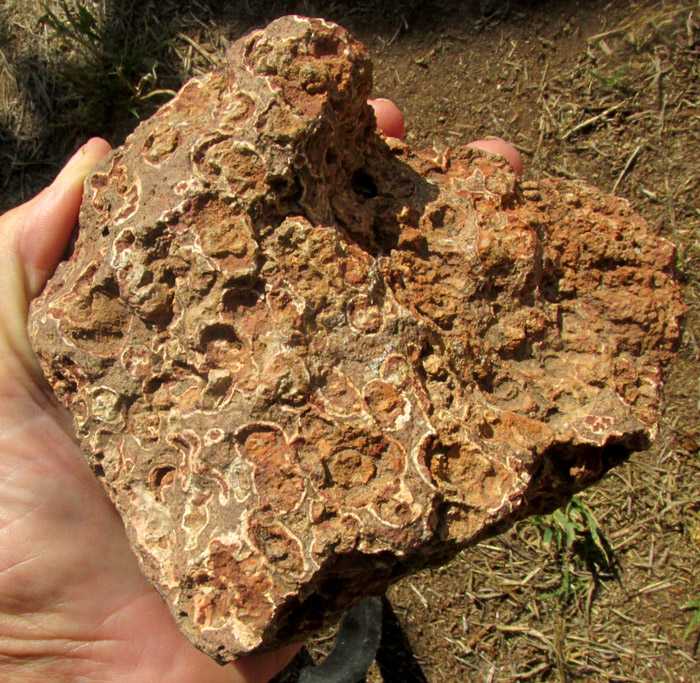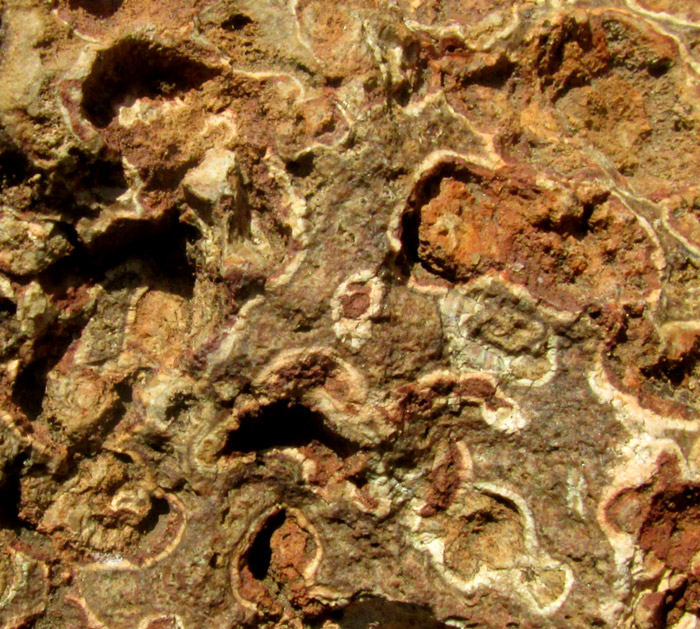Excerpts from Jim Conrad's
Naturalist Newsletter
Entry dated December 11, 2023, issued from near Tequisquiapan; elevation about 1,900m, (6200 ft), ~N20.57°, ~W99.89°; Querétaro state, MÉXICO
AMYGDULES

This area lies at the southern end of the Mexican Plateau, or Mexican Altiplano, within sight of surrounding mountains and ranges, including the famous Peña de Bernal Monolith. This is a transition zone where about an hour's drive west rise foothills of the mostly igneous Sierra Madre Occidental, or Western Sierra Madres, while a similar drive to the east brings us to the mostly limestone outliers of the Sierra Madre Oriental, or Eastern Sierra Madres, and a similar drive southward brings us into volcanic mountains associated with the Trans-Mexican Volcanic Belt. Between the mountains, land is gently rolling with broad, sediment-filled low areas and highly eroded low rises.
On the low rises, the original vegetation of mostly "simiarid tropical deciduous" forest composed of low-growing and often spiny mesquite, acacias and the like gave way to cornfields and cattle ranches, which -- especially because of livestock overgrazing -- has resulted in the topsoil being completely eroded away. Much land has been abandoned, though wandering herds of sheep continue to nibble anything that comes up. On such land, today lose rocks such as the above lie so close to one another that no more than two or three steps can be taken without stepping on one. Rocks of many colors, textures and forms are present, mostly or entirely associated with the pink rhyolite hills just to our east, and slightly upslope. The above is a RHYOLITE ROCK WITH AMIGDULES. Below is a close-up of the amigdules.

Rhyolite is a form of extrusive volcanic rock. The word "extrusive" informs us that the rock began as magma inside a volcano, which was extruded onto the landscape as lava. In the case of our rock, the lava from which it form contained plenty of water and gas. Once outside the volcano, experiencing less pressure than it had inside, the lava's gas gathered into irregularly shaped bubbles. When the bubble-filled lava cooled, it hardened into rock, which was honeycombed with vesicles; vesicles are bubbles fossilized in rock.
The resulting vesicles were empty, except for gas. With time, groundwater or hot solutions of minerals connected with volcanic activity migrated through the rock matrix into the vesicles, gradually filling them with mineral deposits in the form of very slowly growing crystals. In our rock, the process continued long enough to fill the vesicles with crystallized minerals, creating amygdules. Amygdules are vesicles filled with crystalline mineral deposition, usually of the minerals quartz, calcite, zeolite, chalcedony or agate, and hematite. Typically the crystalline deposition is white. In the above rock, the vesicles' outer surfaces are white, but most of the interiors are filled with what probably is reddish-colored iron oxide, or hematite. The large iron content may explain why the above rock felt unreasonably heavy for its size. Rocks filled with amygdules are said to be amygdaloidal.

The above picture shows a side of our featured rock. Note that toward the rock's bottom the amygdules have been stretched out and flattened. This is "flow banding," indicating that during the early cooling of the lava of which our rock was formed at least this part of what became our rock remained molten enough to be moving, distorting and collapsing its bubbles.
The 2007 edition of the Mexican Geological Service (SGM) Geological Mining Map of the Tequisquiapan Quadrangle, F14-C67, indicates that our local rhyolite outcroppings were erupted from volcanoes about 3 million years ago during the Pliocene Epoch of the Neogene Period. During that time, the western mountains of North America and Mexico were rising, attended by much volcanic activity. The land was populated by mastodons, saber-tooth tigers, sloths, llamas and other now-extinct, large mammals. Also, in Africa, there were close-to-human primates of the genus Australopithecus, from whom the human genus Homo someday would emerge.